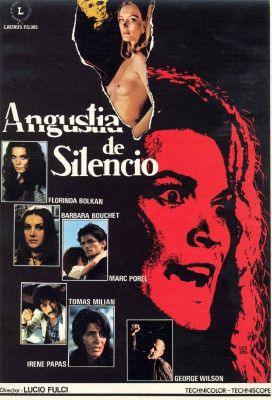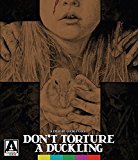| Reviews & Columns |
|
Reviews DVD TV on DVD Blu-ray 4K UHD International DVDs In Theaters Reviews by Studio Video Games Features Collector Series DVDs Easter Egg Database Interviews DVD Talk Radio Feature Articles Columns Anime Talk DVD Savant Horror DVDs The M.O.D. Squad Art House HD Talk Silent DVD
|
DVD Talk Forum |
|
|
| Resources |
|
DVD Price Search Customer Service #'s RCE Info Links |
|
Columns
|
|
|
Don't Torture A Duckling
That and other controversial themes limited the film's distribution in Europe, and it wasn't shown at all in the United States until 1999, when Anchor Bay released it to DVD. Fulci made some genuinely good genre films during the 1970s and early-'80, notably this, A Lizard in a Woman's Skin (1971), and the late-stage Spaghetti Western Four of the Apocalypse (1975), but then turned to hard-core gore and splatter films, pictures like Zombie Flesh Eaters (1979), The House by the Cemetery (1981), and The New York Ripper (1982), movies for which he is best known. Health problems and the suicide of his terminally ill wife in 1969 may have contributed to the director's on-set ruthlessness, misogyny, and occasional sadism described by some of the casts and crews that worked with him. It's hard to believe Fulci got his start directing frivolous movies starring the comedy team of Franco Franchi and Ciccio Ingrassia, the Leo Gorcey and Huntz Hall of Italian slapstick.
The story takes place in present-day Accendura, a Southern Italian Village dominated by a colossal modern freeway, raised many stories on huge columns through a mountain pass. In quick succession three local boys, Bruno, Michele, and Tonino, all active in Father Alberto Avallone's (Marc Poreli) church, are brutally murdered. When the second boy's family receives calls demanding a modest (about $10,000) ransom for his return the local police, led by the regional commissioner (Virginio Gazzolo) and Captain Modesti (Ugo D'Alessio) quickly arrest Giuseppe Barra (Vito Passeri), the village idiot who only found the boy's body and thought he'd make a fast lira.
As children's bodies begin to stack up in the local morgue, the media descend upon the small village, including journalist Andrea Martelli (Tomas Millan). An expensive cigarette lighter at one crime scene leads him to suspect wealthy and glamorous Patrizia (gorgeous German-American Barbara Bouchet), lying low at her father's estate following a drug scandal. The police, meanwhile, set their sights on La Magiara (Florinda Bolkan), a gypsy who, in the opening scenes, is seen digging up the skeleton of an infant near that modern freeway, using her bare and bloodied hands, later creating wax figures of the boys which she sticks with pins.
(Mild Spoliers) The movie grapples with too many human failings to count: murder, vigilantism, betrayal of the Catholic Church, prostitution, drug use, pedophilia, discrimination against gypsies, exhibitionism, voyeurism, superstition, blackmail, mental illness. At various times the movie resembles exploitation versions of Ace in the Hole and The Ox-Bow Incident. Others have called it a giallo Harper Valley P.T.A..
The film is at once unseemly yet intelligent and ambitious. The visually striking freeway, for instance, comes to symbolize a kind of progress where modern, middle-class Italians can whiz past insignificant, Old World-style villages like Accendura, oblivious to its remote-seeming but fundamentally Italian concerns. High society Patrizia lounges, sometimes tantalizingly nude, in a modern house similar to the settings of most gialli, but the rest of the town has that early postwar Neorealist ambiance
That same look was later nostalgically recreated in Cinema Paradiso, but here those same loveable characters become predators, Peeping Toms, bloodthirsty vigilantes, and lunatic priests. It's not a flattering portrait, with Bouchet and Millian especially treated far more identifiably sympathetically than any of the locals. Even the police, not often treated favorably in ‘70s Italian films, come off better than the villagers, who for much of the film are little better than a sweat-soaked mob.
The movie's gore effects are crudely realized but elaborately conceived. One protracted, vicious beating is particularly hard to watch, even though the makeup appliances and fire engine red "blood" is clearly unreal by today's clinical standards.
Video & Audio
A three-page booklet essay details the movie's arduous 2K restoration, sourcing a badly damaged original Techniscope camera negative and a 4-perf duplicate negative. Arrow Video clearly put in a lot of man-hours restoring and fixing innumerable issues, and the results are very impressive. The lossless English and Italian language versions (with optional English subtitles) were sourced from optical soundtrack negatives. The Blu-ray is Region A encoded, while an accompanying DVD version is Region 1 with Dolby Digital mono audio.
Extra Features
Arrow Video's glut of supplements here is about equal to three Criterions. They include a new audio commentary by genre scholar Troy Howarth; a new video essay featuring another, Mikel J. Koven, who really gets into the nuts and bolts of giallo filmmaking and exhibition; a new video essay by Kat Ellinger, which looks at the misogyny in Fulci's films; "Lucio Fulci Remembers," an audio interview with the director from 1988; new video interviews with actor Florinda Bolkan, cinematographer Sergio D'Offizi, assistant editor Bruno Micheli, and assistant makeup artist Maurizio Trani (on the Blu-ray only). The sleeve is also reversible, with original Italian art on one side, newly commissioned artwork by Timothy Pittides on the other.
Parting Thoughts
A genre landmark lovingly restored and buttressed with scads of supplementary features, Don't Torture a Duckling is a DVD Talk Collector Series title.
Stuart Galbraith IV is the Kyoto-based film historian largely absent from reviewing these days while he restores a 200-year-old Japanese farmhouse.
|
| Popular Reviews |
| Sponsored Links |
|
|
| Sponsored Links |
|
|
| Release List | Reviews | Shop | Newsletter | Forum | DVD Giveaways | Blu-Ray | Advertise |
|
Copyright 2024 DVDTalk.com All Rights Reserved. Legal Info, Privacy Policy, Terms of Use,
Manage Preferences,
Your Privacy Choices | |||||||














